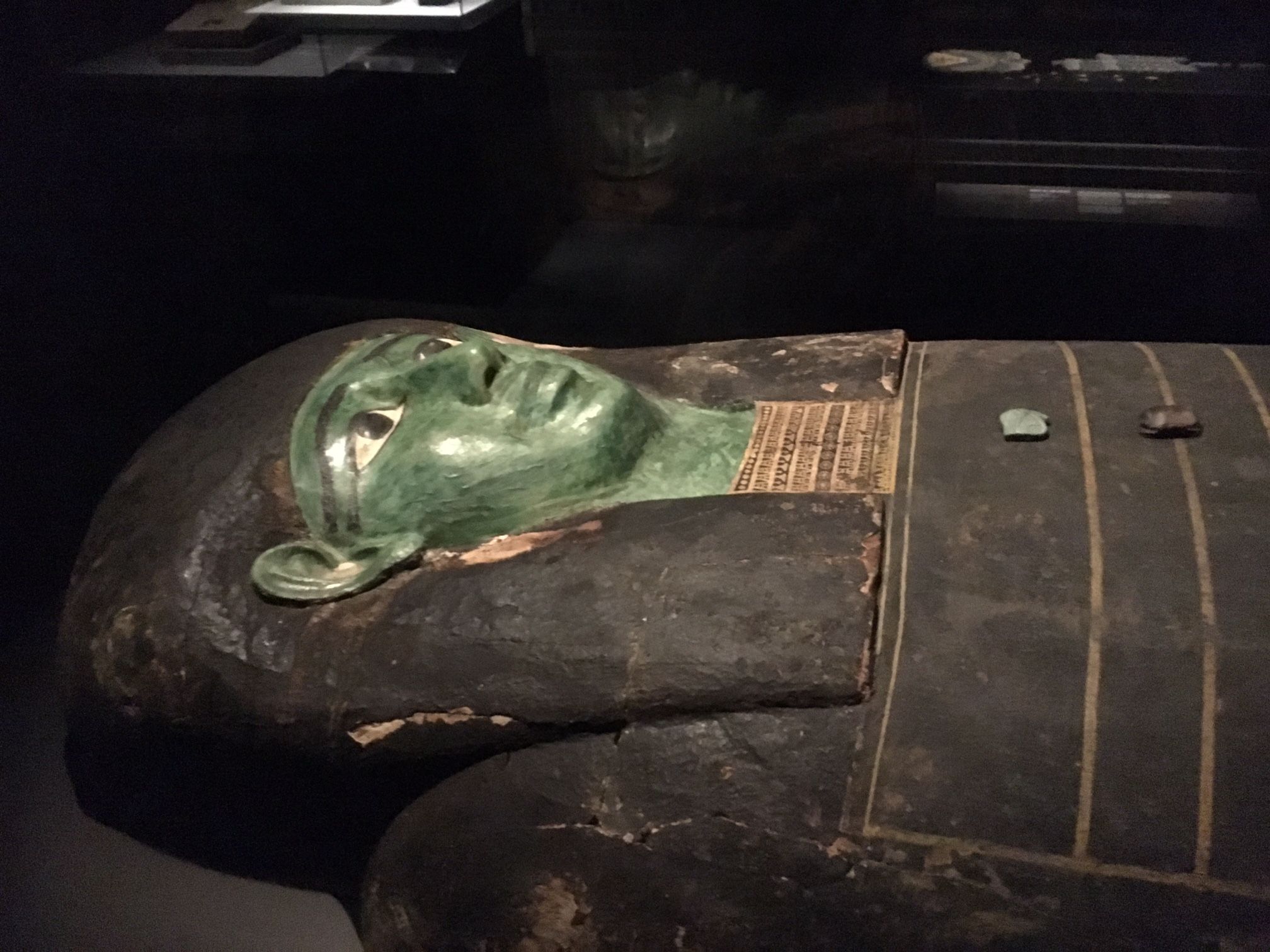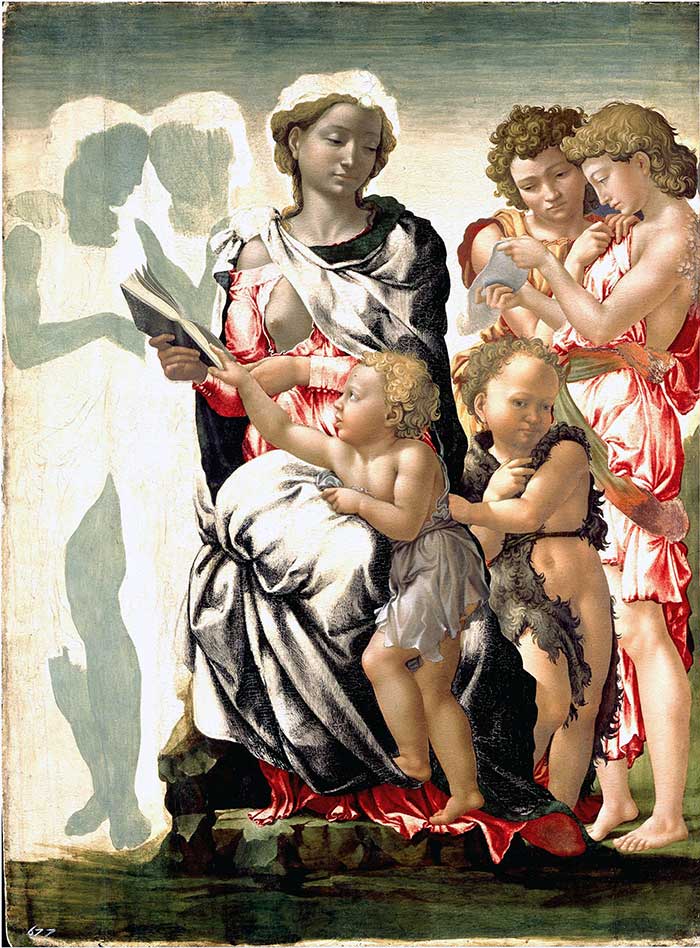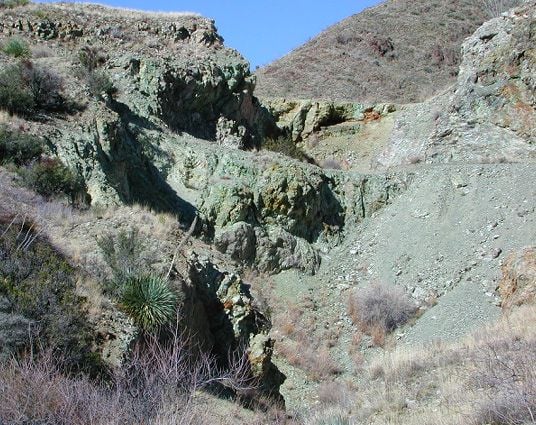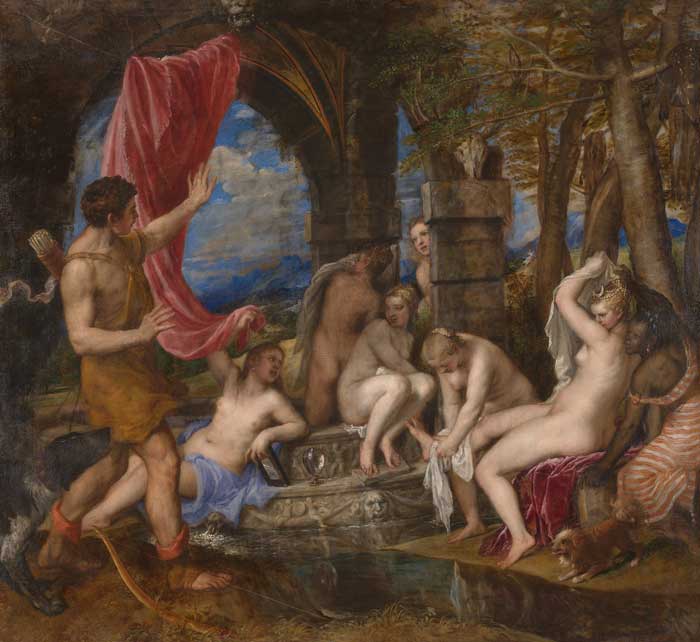

Michaelangelo, The Madonna and Child with St John and Angels (c. 1497), also known as the Manchester Madonna, an unfinished painting attributed to Michelangelo, tempera on panel, 105 cm × 76 cm (41 in × 30 in), National Gallery, London
Malachite, a mineral of copper, is one of the most beautiful minerals known. In nature, this relatively soft mineral usually shows various tints of green, varying from dark, rich green to bright green. Since the earliest civilizations, it has been carved into art forms, semiprecious jewelry, or ground into a fine powder for use as an artist's pigment.

Malachite is a mineral found in many parts of the world in dry or semiarid regions, usually near the surface, and is a good indicator of deeper copper deposits. Chemically, it is a combination of copper(II) carbonate and copper(II) hydroxide, Cu₂CO3(OH)₂.

It is usually associated with azurite, the blue basic carbonate of copper Cu3(CO3)2(OH)₂, which contains less bound water, and chrysocolla—a copper silicate mineral Cu₂H₂Si₂O₅(OH)₄. Malachite is more abundant in nature than azurite. Large deposits have been found in the Ural Mountains of Russia, the Katanga Province of Congo, and Chile. These have been important sources of malachite for lapidary purposes in recent times. The sources of malachite used in medieval European painting are not well known, although there is mention of copper mines in Hungary as being a probable source of both azurite and malachite, and it is well known that there were ancient copper mines in Eastern Europe, such as in the Carpathian Mountains. Vanoccio Biringuccio, the fifteenth-century Italian metallurgist, writes of “green azure,” which the translator says is probably malachite; it is related to “German azure” (azurite). In the Smith-Gnudi translation [Smith-Gnudi 118], it says:
This is more or less green or blue according to the quantity of mixture and more or less abundant according to the powerful exhalation of the ore. It is also gathered with care from the colored stones and is cleaned and made fine by washing and grinding. That which is the finest and of the loveliest color is the most highly esteemed by the master painters.

Many deposits of copper ores in China and Japan served as sources of malachite in Asia. Malachite is widely available from mineral dealers and lapidary stores in various forms. However, the bulk of malachite today is derived from sources primarily in Africa and Chile.
History
Malachite is a historical pigment having been found in Egyptian tomb paintings. Lucas says that malachite was used in Egypt for eye paint as early as predynastic times and has been found on tomb paintings from the 4th Dynasty (c. 2625–2500 B.C.E) on [Lucas]. Numerous examples of malachite have been found on stone and wooden artifacts; examples include several coffins dated to the 26th Dynasty (c. 664–525 B.C.E.) [Hedegaard].
Although abundant in many different locations on the earth, it does not appear to have been used in European painting nearly so extensively as azurite. Malachite is also less frequently mentioned than azurite in written sources [Harley]. The reason may be that to be useful as a bright green color, it must be coarse because if finely ground, it becomes too pale for practical use. Being moderately low in refractive index, it was more satisfactory in tempera than in oil medium. Daniel Thompson also speaks [Thompson 161] of its sparse mention in medieval literature. It may also be true that artificial copper greens, like verdigris and copper resinate made from malachite or other copper minerals, were more satisfactory greens, especially in oil or in oil-resin mediums [Kuhn].
In Daniel Thompson’s translation of Il Libro dell'Arte, Cennino Cennini described its preparation and use in tempera and fresco painting. Writing for late medieval artists:
A half natural color is green; and this is produced artificially, for it is formed out of azurite; and it is called malachite. I will not tell you how it is produced, but buy it ready-made. This color is good in secco, with a tempera of yolk of egg, for making trees and foliage, and for laying in. And put the lights on it with giallorino. This color is rather coarse by nature, and looks like fine sand. For the sake of the color, work it up very, very little with a light touch; for if you were to grind it too much, it would come out a dingy and ashy color. It should be worked up with clear water; and when you have got it worked up, put it into the dish; put some clear water over the color, and stir the water up well with the color. Then let is stand for the space of one hour, or two or three; and pour off the water; the green will be more beautiful. And wash it this way two or three times, and it will be still more beautiful. [Cennini 31,32]

Andrea del Verrocchio, The Virgin and Child with Two Angels,1467–1469, tempera on wood panel, 69.2 cm × 49.8 cm (27.2 in × 19.6 in), National Gallery, London
An example of malachite use in the Renaissance is in the tempera painting by Andrea del Verrocchio and his assistant (Lorenzo di Credi) of The Virgin and Child with Two Angels (c. 1476–8) in the National Gallery of Art, London. The dark green lining of the Virgin's cloak and the angel's tunic on the right contain coarse malachite ground to retain the mineral's color. Malachite was still widely used in Florence at this date. The paints have darkened as a result of the discoloration of the egg medium surrounding the pigment particles [Dunkerton].
A variety of particle sizes and shapes are observed in many Florentine paintings of this period; some are perfectly spherical, others appear to be broken fragments of larger spheres, and others are angular. Although spherical particle shapes were believed to indicate artificial malachite, it is now known that spherical malachite can be naturally produced when precipitated under certain conditions, such as when it originates from water running from copper mines.
It can be seen in the green sash of the angel on the far right in Michelangelo’s Manchester Madonna The Madonna and Child with St John and Angels (c. 1497), also known as The Manchester Madonna, is an unfinished painting attributed to Michelangelo in the National Gallery, London.

Raphael, Madonna di San Sisto or Sistine Madonna, 1513–1514, oil on canvas, 265 cm × 196 cm (104 in × 77 in), Gemäldegalerie Alte Meister, Dresden
Another example of malachite usage can be found in the Sistine Madonna, an oil painting by Raphael, dated c. 1512, which is now in the Gemäldegalerie Alte Meister (Old Masters Picture Gallery) in Dresden. In the upper part of the painting, the green drapery is obtained using several components such as lead white, charcoal black, orpiment, and malachite.

Titian, Diana and Actaeon, 1556–1559, oil on canvas, 185 cm × 202 cm (73 in × 80 in), ;National Gallery and Scottish National Gallery, London and Edinburgh
Malachite is the cool bluish-green of the leaves on the large trees and in the highlights of the smaller trees and bushes in the distant landscape in both Diana and Actaeon and Diana and Callisto by Titian. The coarsely ground mineral gives the paint not only a characteristic color but also a very evident texture. This pigment was not used often by Titian, but Tintoretto and especially Veronese used it regularly (although, unlike Titian, they used it mainly in the underpainting). While it is hardly found at all in oil paintings in the first half of the sixteenth century it seems that by the second half, in Venice at least, it was becoming reasonably widespread [Dunkerton].
In 1794, the French chemist Joseph Louis Proust thermally decomposed copper carbonate to CO2 and CuO and thus identified and separated the exact components of malachite: copper, carbon, and oxygen. Based on his findings, Proust proposed the law of definite composition or proportions, one of the primary laws of chemistry, which states that chemical compounds are formed of constant and defined ratios of elements. Accordingly, the composition of malachite is always the same, regardless of its source or appearance.
Sources of Malachite
Malachite is basic copper carbonate found in many parts of the world in the upper oxidized portions of copper ore deposits. Notable occurrences include many classic mineral localities such as Shaba, Congo; Tsumeb, Namibia; Ural Mountains, Russia; Mexico; several sites in Australia; England and several localities in the southwestern United States, especially in Arizona. Malachite is a secondary mineral of copper, forming when other chemicals alter copper minerals. It occurs when carbonated water interacts with copper minerals or when a solution of copper interacts with limestone.

Georgius Agricola, the father of mineralogy, describes the process of mining malachite in his book, De Re Metallica:
Such waters, whether flowing from springs or tunnels, are collected in many wooden tubs or tanks arranged in consecutive order and deposit in them such juices or earths; these being scraped off every year, are collected, as chrysocolla in the Carpathians and as ochre in the Harz [Agricola 585].
Agricola [De Natura Fossilium 215], in discussing substances that originate from copper, gives among them green chrysocolla and says: “Native chrysocolla originates in veins and veinlets, and is found mostly by itself like sand, or adhering to metallic substances, and when scraped off from this appears similar to sand. Occasionally it is so thin that very little can be scraped off. Or else it occurs in waters which, as I have said, wash these minerals, and afterward it settles as a powder. At Neusohl in the Carpathian, green water flowing from an ancient tunnel wears away this chrysocolla. The water is collected in thirty large reservoirs, where it deposits the chrysocolla as sediment, which they collect yearly and sell”—as a pigment. This description of its occurrence would apply equally well to modern chrysocolla or malachite. The solution from copper ores would deposit a green incrustation of mostly carbonates.
Permanence and Compatibility
Malachite has often proved to be permanent in oil paintings, although it may acquire a dull, brownish hue owing to the darkening of the oil. It is unaffected by exposure to light. In theory, copper carbonate is blackened by sulfur compounds so that it may be affected by exposure to hydrogen sulfide found in polluted air. It is said to be incompatible with sulfide pigments, such as cadmium yellow, orpiment, realgar ultramarine, and vermilion. Even though theoretically subject to blackening when mixed with sulfide pigments, this has never been reported in practice. According to A. H. Church [Church 200], in tempera paintings, it is found to have stood well. Malachite passages on Italian frescoes are often still bright green. Malachite is unaffected by cold dilute sodium hydroxide but blackens when warmed in that substance; dilute acids, even acetic acid, decompose it.
Preparation
To use malachite as a pigment, crush the rock, grind it to a fine powder, wash, and levigate it. One method of levigation is to swirl the ground powder in a bowl and immediately pour the water into another bowl. The heavier particles collect in the bottom of the first bowl, while smaller, lighter particles are poured off into the second bowl. Repeat this step several times to gather different pigment grades, but principally collect three grades: coarse, medium, and fine particles to produce corresponding dark, medium, and light tones of green paint when used with an aqueous medium. The particles of the coarse grade may range from 40 to 160 micrometers, with 75% being 80–120 micrometers. Medium particles range from 4 to 54 micrometers, at least two-thirds being 4 to 14 micrometers. The particles of the fine grade range from 1 to 11 micrometers, with 92% being 1–5 micrometers. The dimension measured was Feret’s diameter, a measure of the particle size along a specified direction. Generally, it is defined as the distance between the two parallel planes restricting the object perpendicular to that direction.
Oil Absorption and Grinding
Malachite must be coarse ground to be useful as a bright green because, if too finely ground, it becomes too pale for practical use. Cennino Cennini remarks, “if you were to grind it too much, it would come out a dingy and ashy color.” As these pigments depend for their color on light transmitted through them, it follows that excessive grinding, by increasing the reflecting surface and resultant scattering of light, will reduce their effectiveness as colors in any medium of low refractive index. Being moderately low in refractive index, it may be more useful in an aqueous media, such as tempera, than in oil-medium. However, beautiful results have been achieved with this pigment in oil.
No data has been published on the oil absorption properties of malachite. In our tests, 100 grams of pigment absorbs 25 grams of oil. This amount will vary depending upon the grade of malachite.
Toxicity
Malachite is moderately toxic, and care should be used in handling the dry powder pigment to avoid inhaling the dust. Direct copper carbonate poisoning is rare. Inhalation of extremely high concentrations of the powder could cause pulmonary edema. Prolonged or repeated overexposure may cause liver, kidney, and blood system damage. Copper carbonate should not be released into the environment as it may be dangerous for fish and animals.
References
Agricola, Georgius. De Re Metallica. Translated from the First Latin Edition of 1556 by Herbert Clark Hoover and Lou Henry Hoover. Last Accessed Online on July 1, 2022: https://www.gutenberg.org/files/38015/38015-h/38015-h.htm
Agricola, Georgius. De Natura Fossilium. Translated from the first Latin edition of 1546 by Mark Chance Bandy and Jean A. Bandy. Dover Publications, Mineola, New York 2004.
Cennini, Cennino d’Andrea. The Craftsman's Handbook Il Libro dell'Arte. Translated by Daniel V. Thompson, Jr. Yale University Press 1933.
Church, Arthur H. Chemistry of Paints and Painting. Seeley, Service & Co., Ltd, London 1915.
Dunkerton J. and Syson L. ‘In Search of Verrocchio the Painter: the cleaning and examination of “The Virgin and Child with Two Angels”’, National Gallery Technical Bulletin 31, 2010, 4–41.
Dunkerton, J. and Spring, M., with contributions from R. Billinge, H. Howard, G. Macaro, R. Morrison, D. Peggie, A. Roy, L. Stevenson and N. von Aderkas. ‘Titian after 1540: Technique and Style in his Later Works’, National Gallery Technical Bulletin 36, 2016, 6–39.
Harley, Rosamond D. Artists' Pigments C. 1600–1835, Butterworths, London 1970.
Hedegaard, S.B., Delbey, T., Brøns, C. et al. Painting the Palace of Apries II: ancient pigments of the reliefs from the Palace of Apries, Lower Egypt. Heritage Science 7, 54 (2019).
Kuhn, Hermann. ‘Grunspan und seine Verwendung in der Malerei’, Farbe und Lack, 70, 9 (1964), 703–711.
Lucas, Alfred and Harris, J. R. Ancient Egyptian Materials and Industries, 4th ed., Edward Arnold Ltd, London 1962.
Smith, Cyril S., and Gnudi, Martha T. The Pyrotechnica of Vannoccio Biringuccio. American Institute of Mining and Metallurgical Engineers, Inc., New York 1945.
Thompson, Daniel V. The Materials and Techniques of Medieval Painting. George Allen & Unwin Ltd., London 1936.
| Pigment Names | |||||||
| Origin: | Malachite is derived from the Greek mallows, μολόχες an allusion to its color | ||||||
| Common Names: | Chinese: shí lǜ 石律 English: malachite French: malachite German: Malachit Italian: malachito Japanese: rokusho 緑青 Russian: Малахит Spanish: malaquita |
||||||
| Synonyms: | English: chrysocolla, green verditer, green bice, Hungarian green, mineral green, mountain green French: vert de montagne German: Berggruen, Malachitgruen Italian: verde minerale |
||||||
| Alternate Names: | It is also known as copper green, green bice, and green verditer, although these names are usually given to the synthetic pigment. | ||||||
| Nomenclature: |
|
||||||














